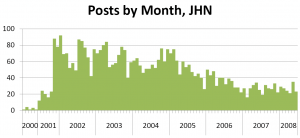Sometimes I think I should title this after the first real post on the blog: Quarterly Update (XXVIII). I was so optimistic back then, June 11, 2001, that I never promised anything more than occasional updates. Fortunately, I kept writing, and somehow the habit stuck, through seven years.
Right now the seven years of this blog represent the second longest time interval I’ve spent doing one thing in my adult life (the first would be, of course, being married to my wonderful wife). The blog has been through three different hosts and two different platforms, starting with Manila on UserLand’s EditThisPage.com, moving to my own Manila site and domain name at Weblogger, and then just a month or so ago migrating to WordPress. Along the way, there have been four major redesigns: a Bryan Bell theme, two scratch-built CSS themes, and the current tweaked theme from Excel.

According to WordPress’s stats, the result has been around 4,100 posts, give or take, along with a handful of longer pieces and a bunch of images. The quantity per month, and per year, has fallen off since 2002, but hopefully the quality is increasing (see the chart below for details).
A few fine points on the chart:
- As always, my blogaversary date is fungible. I began regular posting in June 2001, but there were a small handful of posts in 2000 as well. If I wanted to, I could say that the blog is older than the Tin Man, who began in January 2001, but that wouldn’t be fair.
- The main sea change in my posting rate happened at the end of 2005, when I took on the Boycott Sony blog in addition to my posting here. There’s not likely to be an event like that to make me slow down here again.
- My posting frequency was falling off a little this year, until I migrated to WordPress. Now there’s an uptick that I think will continue to go.
- There’s an inverse relationship between periods in which I was happy with my work and posting frequency. I’m really glad to say that, since 2005, I haven’t been going crazy with the posting.
Of course, the post counts are easy to skew. I used to post two and three sentence posts, now I save that for the linkblog.
So why do I keep posting, anyway? I’ve always liked sharing things I found with people, and apparently people like to read it. Plus there’s my other, time-delayed audience: Google. It’s really rewarding to see what people have found useful in the blog, a long time after I wrote it. Now that the blog has comments again, I’m looking forward to having a more interactive relationship with you, my readers.
My hope is that I will keep doing this for the next seven years, and beyond, and that you’ll stay with me for the ride.

